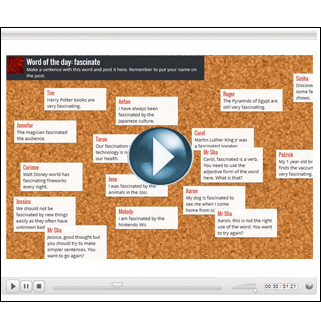Quick overview: Padlet and Lino allow teachers and students to assemble a variety of text, images, or videos on a virtual bulletin board. Either one of these tools allows one to share a collection of related “bite sized” ideas. Multiple students can work on the same board simultaneously. Boards can be public or private.
What are Padlet and Lino? Padlet and Lino are actually two different tools but are quite similar in regards to functionality. Both tools allow you to add text, images, and videos to a virtual board. You can even attach Word, PowerPoint, and Excel documents too. Both tools work on smartphones, iPad, and Android devices.
How can use these two tools be used in the classroom? I’ve linked to detailed tips how padlet and how lino can be used in a classroom. For a more broad overview, these two tools can be used for:
– Class research board(s) around one topic
– Class brainstorming/suggestions/questions
– Gathering needs or goals from multiple students in one place
– Debates/Viewpoints (on a private board)
– Vocabulary/Verb boards
I’m confused! Both tools sound exactly the same: It really comes down to looking at both and seeing which one you think would be a better fit for yours students. I’ve included a link of how the tools work and a detailed comparison between the two. On Brainstorming with these tools: In an earlier blog post, I highlighted how you can use Wordle used to break down text and allow your students to literally “see” the most predominant words (i.e. – themes) used throughout the text. A neat idea is to manually copy all the text from a finalized Padlet/Lino into Wordle to create a Wordle word cloud based on the class brainstorm.
On Brainstorming with these tools: In an earlier blog post, I highlighted how you can use Wordle used to break down text and allow your students to literally “see” the most predominant words (i.e. – themes) used throughout the text. A neat idea is to manually copy all the text from a finalized Padlet/Lino into Wordle to create a Wordle word cloud based on the class brainstorm.
Link: www.padlet.com and en.linoit.com
Doesn’t Lino look a little familiar? Yes, Lino is similar to Corkboard.me, a tool I blogged about in March 2012. However, Corkboard.me is no longer available in its old format. (Source: Jim Hirsch’s “Learning Jams: Improvising BYOD Learning Opportunities in Your Classroom” ISTE 2013, San Antonio. Also thanks to Tony Vincent’s Learning in hand and The Teachersfirst website.)
